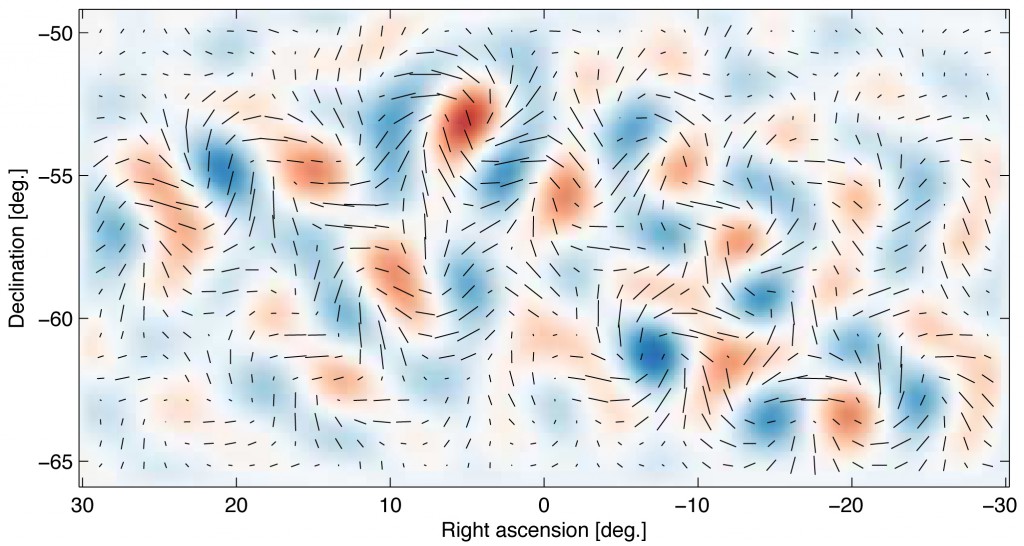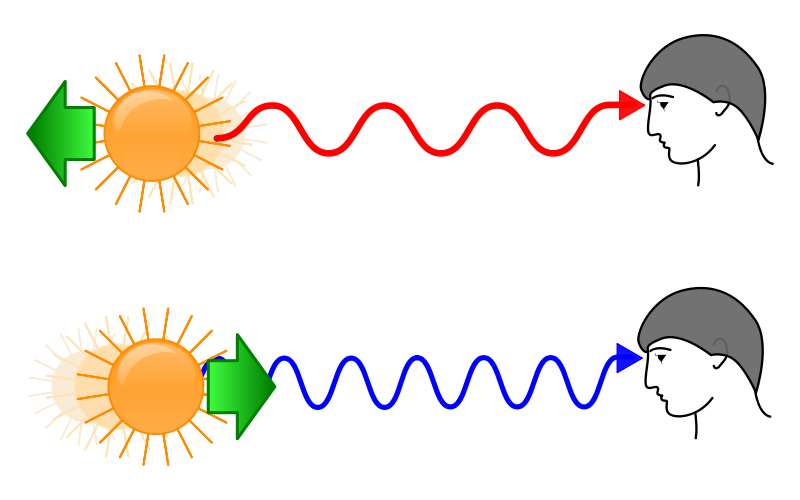
Inflation’s Aftereffects
It hasn’t been the most diverse week in science news, mainly because of what’s being touted as the biggest news in science since the confirmation of the Higgs Boson, the BICEP2 Collaboration team announced this week the discovery of twisting patterns of polarity in the Cosmic Microwave Background — extremely strong evidence for the inflationary model of the Big Bang. In honor of the discovery, and because it’s so, so important, I’m going to spend today’s post trying to explain just what that means to anyone who doesn’t already: from the Doppler effect, to Hubble’s expanding universe, to the Big Bang, to the Cosmic Microwave Background, to inflation and to gravity waves. If you know about all of this stuff already I’ve got a “Best of the Rest” segment at the bottom, but if not, strap in, we’re going for a ride:
What the Hell is a Gravity Wave, and Why Do I Care?
This week’s discovery is all about our model of the way the universe came into being, and to understand it, we need to back up a little. The Big Bang theory’s origins lie in the early 1900s, when it was discovered that everything in space — all the other galaxies, clusters, superclusters — were getting further and further away. We can tell this because the light from them is more red than it would otherwise be. This is due to the Doppler effect.
The Doppler Effect

Physical objects and light act differently. If you stand on top of a moving train and throw a baseball forward, it’s going to go as fast as you threw it plus the speed of the train. If you throw it backward, it’s going to go as fast as you threw it minus the speed of the train. So if the train is going 50km/h and you throw the ball forward at 10km/h, it’s suddenly going 60km/h. If you throw it backward at the same speed, it’s going 40km/h. These speeds are, of course, relative to the ground.
Light is different, because it always travels at the same speed (in a vacuum like space, anyway): no matter how fast the “thrower” is moving, or what direction, it goes the speed of light. Shine a light forward while on a moving train, and it’ll move the speed of light. Shine a light backward, still the speed of light.
What does change is the frequency.
See that picture above? Think of the frequency of light like a spring. Things moving away from you get stretched out, while things moving toward you get squeezed together. Stretched out light is more red, and squeezed light is more blue, so knowing this, we can actually tell how things are moving about (relative to us) in the universe.
Edwin Hubble
In the early 1900s, astronomers had discovered that most of the things in the universe were red-shifted. That meant things were moving away from us. In 1929, Edwin Hubble (the guy who the Hubble Space Telescope is named after) discovered that the further things are away from us, the faster away from us they’re moving. What did that mean?
Imagine you’re standing in a flat field. You have a friend that’s walking away from you at 5km/h. He’s going to be a little bit red-shifted. Now imagine you have a second friend moving away from him at the same speed. To you, he’s going 10km/h away from you.
This is what Hubble saw: the further things got away from Earth, the faster away from us they appeared to be going. The only explanation was that space itself was expanding, evenly across the universe. Everything was getting farther away from everything else at the same speed.
The Big Bang vs. The Steady State
In 1931, Georges Lemaitre proposed that, since all things were expanding away from each other, then at some point it all must have been in one spot. People at first thought this was crazy — the universe was infinite and unchanging, always in what they called a “steady state.” The term “Big Bang” was actually used as an insult by people who thought it was a crazy idea, but eventually people came to use it to describe the theory even when they thought it was right. Over time more and more evidence piled up.
Because light travels in all directions at the same speed, we know that the further away something is, the longer ago it happened. Just like you won’t hear a gunshot at a distance until long after it happens, we can see the light emitted billions of years ago in the vast cosmic distance. So one thing astronomers saw was that at greater distances (that is, longer ago in time) they saw different kinds of stars than at closer ones (that is, more recent light). This suggested that the universe wasn’t in a “steady state” — it was changing over time.
The Cosmic Microwave Background
In 1965, scientists found the “smoking gun” of the Big Bang. When we look at the furthest edges of what we can see, the oldest light in the universe, there’s what amounts to a low-level hum. This is the Cosmic Microwave Background: light left over from when the universe was only a few hundred thousand years old, and was still so hot that it glowed, the way iron glows when you heat it up. This fit perfectly with the predictions of the Big Bang theory, down to the age of the light and its distance.
Gravity Waves
This brings us to this week’s announcement. One thing that the Big Bang theory calls for is something kind of insane, called “inflation.” The problem with the theory was that we couldn’t explain why the universe was so uniform. Why is the Cosmic Microwave Background so uniform? The temperature is completely uniform up to 1 part in 100,000.
The way the Big Bang theory dealt with this was through inflation: for the briefest moment in the universe’s history, from the time the universe was 10e-36 seconds old (0.0000000000000000000000000000000000001 seconds old) to the time it was 10e-32 seconds old (0.000000000000000000000000000000001 seconds old), the universe expanded faster than the speed of light. We’re talking about a span of time roughly one billionth of one trillionth of one trillionth of a second, when it expanded from a subatomic size to the size of a golf ball — something like 10e50 times (100,000,000,000,000,000,000,000,000,000,000,000,000,000,000,000,000 times) its original size. That may not sound like much, but for scale of reference, that’s roughly the difference in size between a golf ball and something several orders of magnitude bigger than the entire universe today.
This kind of expansion, according to some theories, would have left indelible marks on the structure of the universe. Enormous cosmic “stretch marks,” if you will, that we call “gravity waves,” ripples or distortions in the fabric of spacetime itself.
That’s exactly what the researchers announced they’d found this week: a twist in the orientation of the light from the Cosmic Microwave Background that lines up perfectly with one model of this inflation. It isn’t proof positive, but it has what’s called a “sigma value” of between 5 and 7. That means that there’s only a one in ten million chance that this reading is a statistical fluke — which means we’re pretty darn sure it’s the real deal.
Why Do I Care?
One, this gives us an observational window into the beginning of the universe. Before, we could only see as far back as about 300,000 years after the Big Bang. These gravity waves actually give us insight into the first trillionth of a trillionth of a trillionth of a second of the universe’s existence, and that itself is amazing because it means we’ll be able to design experiments to test new theories about the origins of the universe. Two, it also lets us know about “dark energy” — the increasing expansion of the universe — and the future fate of the universe. If the first period of inflation ended, maybe the current period of inflation will end, too. It also helps the possibility of the multiverse — most models of inflation lead to a multiverse. Overall, it opens up the universe as we understand it, in ways we haven’t even considered yet.
Here are some good links for more on the story: Quirks and Quarks, New Scientist, Scientific American, The Independent, Space.com, LiveScience, NPR, Discover, National Geographic, and Gizmodo.
So to conclude: here’s a brief video making the rounds of Andrei Linde (the man who predicted this precise scenario playing out thirty years ago) getting the news this week.
And Now, The Best of the Rest
There were two big pieces of news this week in Alzheimer’s research: scientists have found a protein that could protect against the disease, and others have found a blood test that can predict the disease with 90% accuracy up to three years before symptoms present. We’ve also seen the surface’s of Titan’s hydrocarbon seas, that we nearly had another Carrington Event last month, and that China’s Jade Rabbit isn’t totally dead. Also, Google’s in trouble for mining student e-mails, and Microsoft has always reserved the right to read your e-mail, so don’t say anything sensitive, I guess. That’s all for today.
Have a great week!

